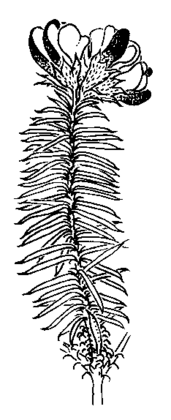Common name: Olinda Bush-pea
Pultenaea aculeata M.A.M.Renner, P.H.Weston & S.Clarke APNI* Synonyms: Pultenaea sp. Olinda (R.Coveny 6616) APNI*
Pultenaea sp. E sensu Weston (1991) APNI*
Pultenaea johnsonii Tindale ms. APNI*

Description: Erect to procumbent shrub to 4 m; branchlets spreading-pubescent.
Leaves alternate, linear, crowded on upper parts of branches, apex prominently aristate, margins tightly inrolled, adaxial surface enclosed, so appearing terete with a groove on the upper surface, 3.6–14 mm long, 0.4–0.8 mm wide, surfaces discolorous, lower surface darker than upper; stipules 2–3 mm long.
Inflorescence irregular, not terminal, dense but not contracted, leafy, the leaves often smaller and with slightly enlarged stipules; bracts absent. Flowers 8–9 mm long, pedicels 0.5–1.5 mm long; bracteoles c. 3 mm long, lacking stipules, narrow-ovate, aristate, sparsely appressed hairy, attached near base of calyx tube. Calyx 4–5 mm long; lobes acuminate. Ovary glabrous except at base of style.
Pod 5–6 mm long, turgid.
Flowering: August–September
Distribution and occurrence: Restricted to ‘pagoda country’ east of Rylstone, from Brymair Creek east of the Capertee Valley north to the Spring Log Ridge area. Grows in crevices between sandstone boulders with other shrubs.
NSW subdivisions: CWS, CT
Threatened species: NSW BCA: Endangered
Previously included under a broad concept of P. glabra or recognised as P. sp. Olinda (R.Coveny 6616).
Text by M.A.M.Renner & R.L.Barrett, Aug. 2022
Taxon concept: Renner et al., Aust. Syst. Bot. 35: 163 (2022). https://doi.org/10.1071/SB21030
APNI* Provides a link to the Australian Plant Name Index (hosted by the Australian National Botanic Gardens) for comprehensive bibliographic data
***The AVH map option provides a detailed interactive Australia wide distribution map drawn from collections held by all major Australian herbaria participating in the Australian Virtual Herbarium project.
|


